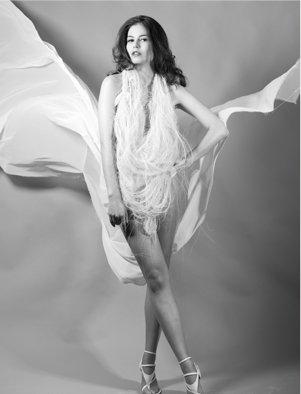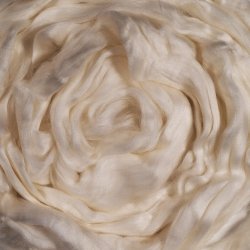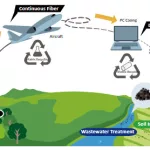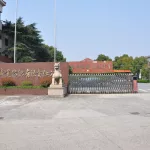German designer Anke Domaske has developed a fiber from disposable milk: Her chemistry-free fiber she names “Qmilch” has been developed from casein can be completely recycled. The raw material casein is won from milk discarded for disposal. In summer she wants to start the fiber´s industrial production in Hanover, Germany.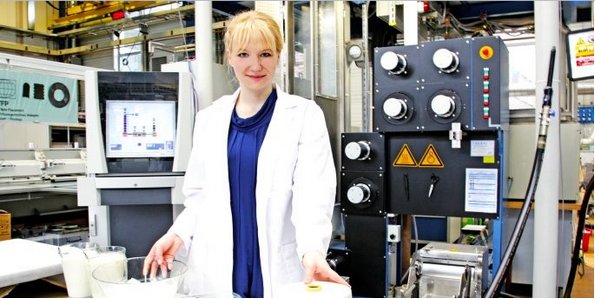 Fashion designer and microbiologist : The 28-year-old Anke Domaske manufactures clothing from milk fibers. Anke Domaske has developed from a chemical-free casein fiber, to relieve suffering and can be biodegraded. It extracts from its raw milk, destined for disposal. She says : “The possibilities are almost infinite”. Anke Domaske, a biologist with a diploma from the University of Göttingen, has been operating for nine years in Hanover, the fashion label “Mademoiselle Chi Chi” – with prominent clientele from Matthew McConaughey (Hollywood) by Barbara Schoneberg (not “Wetten, dass …?”).
Fashion designer and microbiologist : The 28-year-old Anke Domaske manufactures clothing from milk fibers. Anke Domaske has developed from a chemical-free casein fiber, to relieve suffering and can be biodegraded. It extracts from its raw milk, destined for disposal. She says : “The possibilities are almost infinite”. Anke Domaske, a biologist with a diploma from the University of Göttingen, has been operating for nine years in Hanover, the fashion label “Mademoiselle Chi Chi” – with prominent clientele from Matthew McConaughey (Hollywood) by Barbara Schoneberg (not “Wetten, dass …?”).
——————————————————————————————————————-
The Fiber – Qmilch
The fiber-Qmilch Domaske developed in cooperation with the Bremen Fibre Institute (fiber), are first clothes from the new material there from February in the online-shop www.mcc-style.com .
The raw material casein is used since the Stone Age technology, as binders for paints in the cave paintings, as Möbelleim in Ancient Egypt (New Kingdom, 18th Dynasty) and mortar in the Roman Empire. Today, it is also used in drug manufacture and cosmetics. Technical casein is obtained from between five and seven million tons of cow’s milk in Germany because of high consumer protection standards should not be considered as drinking milk within the meaning of § 2 (5) of milk regulation.
The ecological balance of the fiber is compared with traditional natural fibers exceptionally well: Thus, for a kilo of cotton consumed an average of 12,000 liters of water, organic cotton or 7,000 liters. For a kilo of Kaseinfaser barely reach two liters – about 92 liters, if you take into account the water consumption for milk production. Additional water dyeing wrinkles not. The CO2 emission lies with 1,500 grams of CO2 -equivalent per kilo at a level similar or Tencel, organic cotton.
——————————————————————————————————————-
Excerpts of an interview with Ms. Domaske are reproduced below with the courtesy of taz.
Q : cloth out of milk, some are bad?
A : It’s not.
Q : Well, but what’s going to be good because when you process a valuable organic milk to clothes?
A : We do not, yes! Our raw material is good for technical casein, casein das. it means the main protein in milk is …
Q : That’s just it: To win a kilo of casein, I need almost 30 liters of milk?
A : But we indeed derive casein from milk, which is regarded as a waste, because it may no longer be used for food. That would otherwise simply tilted away only.
Q : Because the cows were sick?
A : There are very different examples: the one hand there is the centrifugate, which drops in cheese production and may be used any further. Or is there something in between during transport: about now in the winter. Since it is possible that the milk trucks can not get through to the farmer, because it was snowing and the road is slippery. Five minutes late – and the need to tilt away 10,000 liters of milk. Which, although still somewhat in the order – but the milk regulation in Germany is so strict that no longer allowed to be traded as a food.
Q : Simply: yes, you want to produce your Qmilch fiber now industrially. Since you can not make it subject to such accidents?
A : They have said we are running out of raw material? The problem we are not sure have: Almost 20 percent of milk production in Germany should not be used for food.
Q : What? 20 percent?
A : Yes. This is tragic. Since we’re talking about a few hundred thousand tons a year.
A : Well, rather than a few million tons … … And I can speak only of the German milk production. So much casein in any case can not, as usual, be made into glue or paint or cosmetics and tablets. And even if we were economically already with 560 tons.
Q : How do you get to the milk: the dairy transporters probably does not even call you if he is still stuck somewhere – or is it?
A : No, of course, we have contracts with dairies. As we make our own specifications, so: that the animal must be humanely entertainment, organic farming and so on.
Q : It sounds strange but still, imagine the fluid milk than fiber?
A : The casein is not yet liquid. That many do not understand. If you look at milk, whey and then floats down on top of it so white flakes. This is the casein. If one skims it, one gets the cheese – and is dried. Then you get the egg white powder, which is also known by bodybuilders from the protein shakes. This is then placed in a machine, an extruder, where it is again mixed with water.
Q : How much water?
A : We need more than two liters to this powder to touch …
Q : … on how much powder?
A : I will not tell. The exact mixing ratio is part of the recipe – that must remain secret.
Q : I see. This will be kneaded …
A : Yes, like baking a cake – or perhaps more like the meat grinder because in the end one has such a plate with many holes: 1,000-hole, for example, a known standard. This is the spinneret. Since the mass is pressed – and then you get the fiber.
Q : Sounds easy.
A : It is also, in principle. It is very energy efficient: We have short delivery …
Q : … clear: plenty of milk available here around Hanover.
A : Exactly. We run the machine at low temperatures, well below 100 degrees for very short duration. Currently we manage more than two pounds per hour, because we only have a small machine. We have to gradually scale up to 70 lbs to get a more feasible process. We have no waste products: We also use no chemicals, only water, casein and other natural products. The fiber is biodegradable like all natural fibers. It has all the advantages of a natural fiber. Mattress manufacturers find it great because the fiber has a bulking effect. In conventional natural fibers that would require its own process. I need to take as they are – and adapt to the needs.
Q : How do people react when they hear their new blouse is made from milk fiber?
A : This is quite funny: Most smell to it only once – and then realize that it does not smell. Some also want to try to eat the fiber. I have also tried it myself. It tastes not so great.
Q : That milk makes you beautiful, especially the skin, that’s a classic: Is it important for the marketing?
A : No, the marketing has nothing to do. It was rather the starting point: The fact that milk, like the winding of the quark grandma has one salutary effect, even a traditional knowledge that we have largely forgotten, or no longer use. I think that’s a fundamental problem that we generally no longer rely on what nature offers us, but only depend on synthetic drugs without thinking about it. Because it’s true: casein – or quark – contains 18 different amino acids. Each works differently, such as wound healing or inflammation. Normally, the drugs or foods are added separately.
Q : You studied biology. How did you get the idea to open fashion label “Mademoiselle Chi Chi”?
A : I started embroidering and sewing at a young age, anything that was creative. Science was always my second interest. When I was 19 years old and just came back from Tokyo where I learned ink drawings from the 50s. Two years ago, after finishing my studies, I concentrated again on fashion design. By this time, several prominent Hollywood stars had already started wearing my clothes. I started making fibers from milk. Milk fibres were popular in 1930 but later, were replaced by polyester. However, I realised that it should be possible to develop a natural product – such as milk – as a natural fiber, which of course must be water resistant. That would not be good if the casein-T-shirt dissolves in the first rain. The molecules crosslink in a specific way. If I have a high longitudinal connectivity, the connection is water-resistant – but not sufficient fluidity. And if I have a high cross-linking, it is free-flowing – but not water resistant. So the trick is just to get the right mix, the molecules that connect the right way in order to have control over water and heat. We have not only casein, we have other raw materials – but all natural – so that the ultimate fiber helps you to heal wounds & eczema. I would never claim that it cures the eczema. It can not. What we know is that the milk fiber is smooth & antibacterial. It does not add to the irritatation of the skin and there is a positive influence on wound healing. Today there is a shortfall of one million tons of cotton fiber. The trend is to switch over to viscose rayon which again has a deficit of five million tons. This deficit can not easily be met. We need to look around us for alternatives – and then why not take a waste product that would only be thrown away? This is a resource which is simply wasted. I think we should use it. Brazil that has plenty of goats milk, which is tilted away, is desperately looking for a solution. I don’t know if goat’s milk works well because it has structurally different protein than cow’s milk. We’ve even had requests for trying camel milk from Arabian countries. I do get requests to sell my patent but I am interested in building production and in generating customers. I love my product. And if I can help people with my invention – that’s great. The challenge is rather to build the structure. We had to hire at least eleven people in the beginning since we had not utilized the machine because delivery times are so long that we now have perhaps the chance to get used to. It will take until at least mid-2012 when we get our first machine.
Contact details :
Qmilch GmbH
GeschaftsfOhrerin: Dipl.-Biol. Anke Domaske
Gottinger Chaussee 12-14
30453 Hannover, Germany
Phone: 0049 51137413059 Fax : 0049 5126314435 Email: info@qmilk.eu
